Table of Contents
The secret to effortless customer experiences lies in understanding one simple truth: effort matters. Think about the last time you had to navigate a clunky website or deal with a long-winded support call. Frustrating, right? Customers feel the same way. That’s where Customer Effort Score (CES) steps in to save the day.
CES is laser-focused on one thing: how easy it is for your customers to get what they need. People don’t want complicated solutions. Whether they’re making a purchase, asking for support, or returning a product, they crave simplicity. CES helps you understand if you’re delivering on that promise of ease, which directly impacts loyalty and long-term growth.
By measuring the effort your customers expend, you’re unlocking insights into what works and what doesn’t. High scores mean you’re on the right track. Low scores? That’s a golden opportunity to improve. For businesses looking to thrive, understanding CES is non-negotiable.
In this article, we’re spotlighting the top 5 tools for measuring CES. So, if you’re ready to transform your customer journey from frustrating to frictionless, let’s dive into the CES tools that can make it happen. Trust us – your customers (and your bottom line) will thank you!
Key Takeaways
- CES is a critical metric for understanding how easy or difficult it is for customers to interact with your business. Reducing effort directly boosts satisfaction, loyalty, and repeat business.
- While metrics like CSAT or NPS focus on the big picture – such as overall happiness or loyalty – CES zooms in on the little moments that can make or break a customer’s experience. These are the friction points: those frustrating moments when something that should be easy becomes unnecessarily hard.
- Choosing a CES tool that fits your business needs – whether it’s for automation, real-time feedback, or advanced analytics – ensures you can collect meaningful data and act on it effectively.
- Deploy CES surveys at strategic moments, like after a support interaction or checkout, to capture honest, actionable feedback when the experience is fresh in the customer’s mind.
- CES data is only valuable if you use it. Analyze trends, identify friction points, and implement improvements that make a tangible impact on the customer journey.
What is CES and Why Does It Matter?
The Customer Effort Score (CES) measures one simple but crucial aspect: How easy is it for customers to get what they need from you? Whether it’s resolving an issue, completing a purchase, or finding information, CES gives you a direct look at how much work your customers are putting in. The lower the effort, the better.
Customers don’t just remember the end result of their experience; they remember how they felt getting there. A seamless, stress-free process leaves them happy and likely to come back. A high-effort experience? That’s a recipe for frustration and churn.
How Does CES Compare to Other Metrics?
When it comes to understanding customer satisfaction, CES is part of a powerful CX trio that includes Net Promoter Score (NPS) and Customer Satisfaction Score (CSAT). But each has its unique role:
- CES focuses on effort. It answers the question: How hard did your customers have to work to resolve their issues or achieve their goals?
- NPS looks at loyalty. It asks: How likely are your customers to recommend your business to others?
- CSAT measures satisfaction. It gauges: How happy are your customers with a specific interaction or experience?
While NPS and CSAT are great for understanding overall sentiment and loyalty, CES digs deeper into the process itself. It pinpoints friction points that might otherwise go unnoticed, making it an invaluable metric for improving the customer journey.
What the Research Says About CES?
The numbers don’t lie – effort is a big deal. Studies consistently show that effort is one of the strongest predictors of customer loyalty:
- According to Gartner, 96% of customers who reported a “high-effort” interaction said they were more likely to switch to a competitor.
- According to a Harvard Business Review article reducing customer effort increases the likelihood of a customer repurchasing by 94% and their likelihood of increasing spending by 88%.
These stats highlight a simple truth: Customers value convenience. Make their lives easier, and they’ll reward you with loyalty. Ignore their struggles, and they’re out the door.
Next, let’s dive into the tools that can help you measure and act on this critical metric!
What Makes a Great CES Tool?
To truly understand and reduce customer effort, you need a tool that goes beyond just collecting responses. The best CES tools are like your trusty sidekick – reliable, efficient, and ready to deliver insights when you need them most. Here’s what makes a CES tool stand out:
1. Ease of Survey Creation
Nobody has time to wrestle with clunky software, and your customers won’t appreciate confusing surveys either. A great CES tool should make it a breeze to design clean and simple surveys.
Even better? Your business isn’t generic, and your CES surveys shouldn’t be either. Look for tools that allow you to customize surveys to match your branding, tone, and audience preferences. Whether you want a sleek one-question format or a more detailed follow-up, the ability to tailor your surveys ensures they feel natural and engaging to your customers.
2. Multi-Channel Support for Diverse Customer Touchpoints
Customers interact with your business in many ways – emails, live chat, mobile apps, social media, and more. Your CES tool needs to keep up. Whether your customers are reaching out via support tickets or navigating your website, the best tools offer flexible deployment options to meet them where they are.
3. Integration with CRM and Helpdesk Tools
Your CES tool needs to cooperate, not isolate. It should seamlessly integrate with your existing systems, like your CRM or helpdesk software. This means you can connect the dots between customer feedback and their journey, giving you a clearer picture of what’s working (and what’s not). For instance, if a CES response is tied to a specific support ticket, you can identify exactly where the effort occurred and fix it.
4. Real-Time Data Analytics and Reporting
With real-time analytics, you can monitor responses as they roll in and immediately spot trends or issues. Imagine discovering that customers are struggling with your checkout process just minutes after launching a survey. With these insights, you can address the problem before it escalates into a flood of complaints.
Look for tools that provide intuitive dashboards to simplify data analysis, allowing you to track trends and filter responses by customer segments. Some tools even incorporate text and sentiment analysis, which goes beyond the numbers to reveal customer emotions and recurring themes in feedback. This combination of real-time updates and advanced analytics ensures that your team can take targeted, effective action where it matters most.
After all, knowing a customer struggled is only helpful if you have the tools to do something about it.
5. Automated Alerts and Follow-Ups
Real-time feedback identifies issues, but automation ensures swift action. The best CES tools trigger alerts when low scores are received, enabling your team to respond immediately. For example, if a customer shares negative feedback, an automated alert can prompt a personalized follow-up to resolve the issue.
This proactive approach turns problems into opportunities, showing customers their concerns matter while strengthening relationships. Automation streamlines your team’s workflow and ensures no feedback goes unanswered, keeping small frustrations from becoming big issues.
When selecting a CES tool, the goal is simple: make it easy for your customers to provide feedback and easy for your team to act on it. With these features in mind, let’s dive into the top CES tools that check these boxes!
Review of Top 5 CES Tools
Every business has unique needs when it comes to CES tools. Some prioritize seamless integrations, others need robust analytics, and many just want simplicity and ease of use. That’s why we’ve handpicked five tools that excel in different ways.
Ready to find the one that fits your needs? Let’s explore what makes each tool special and who it’s best suited for.
1. Retently: Automation and Insightful Feedback Analysis
Retently is a comprehensive customer experience management platform tailored for businesses that prioritize actionable feedback. Known for its robust automation capabilities and deep analytics, Retently simplifies the process of collecting, analyzing, and acting on feedback. It specializes in tracking Customer Effort Score, along with Net Promoter Score, and Customer Satisfaction, making it a versatile choice for customer-centric companies of all sizes.
With its multi-channel capabilities, real-time analytics, and AI-driven insights, Retently empowers businesses to identify and resolve customer pain points proactively. Its seamless integrations and automated workflows ensure that every piece of feedback contributes to actionable improvements. By turning challenges into opportunities, Retently enables businesses to reduce effort, build loyalty, and drive long-term growth.
Key Features
Retently’s approach to CES is both comprehensive and user-friendly, making it a top choice for businesses focused on streamlining customer interactions:
- Omnichannel Feedback Collection: Retently enables businesses to collect feedback across multiple channels, including email, in-app, and link surveys. This ensures no interaction is overlooked, whether it’s during onboarding, following a customer support interaction, or after a purchase. The platform supports dynamic surveys tailored to each stage of the customer journey, increasing response rates and relevance.
- Flexible Customization: The survey editor gives you full control to match surveys to your brand’s look and feel. You can adjust colors, logos, and text, and even personalize responses. Moreover, Retently’s survey editor makes it simple to create custom translations, ensuring you can connect with customers in their preferred language without restrictions.
- Customer Segmentation for Personalization: With Retently, businesses can group customers based on behavior, purchase history, geography, lifecycle stage, or other attributes. This targeted approach helps craft personalized feedback campaigns and ensures insights are aligned with specific customer experiences. For example, ecommerce businesses can tailor surveys for frequent buyers versus first-time customers.
- Seamless Integrations: The platform integrates with popular tools like Salesforce, HubSpot, Slack, Intercom, Zendesk, and more, making it easy to incorporate CES data into your broader workflows. By connecting feedback to customer profiles or support tickets, teams gain a unified view of the customer experience, enhancing decision-making and response strategies.
- Automated Alerts and Proactive Follow-Ups: Retently automatically triggers alerts based on feedback thresholds. For example, a low CES score can notify a support agent via Slack or email, enabling immediate follow-up to resolve issues and improve customer satisfaction.
- Advanced Analytics and Predictive Insights: Retently’s real-time dashboards allow businesses to track trends, monitor customer effort scores, and analyze data at a granular level. Its advanced reporting capabilities, including segmented trend analysis and benchmarking, text and sentiment analytics, allow businesses to prioritize areas needing improvement and measure the impact of changes over time.
What Makes Retently Unique?
Retently goes beyond traditional feedback collection by providing actionable insights that help businesses improve customer experiences in real-time. For instance, if a SaaS user reports difficulty during onboarding, Retently highlights specific friction points, enabling the team to address and resolve the issue promptly. Its combination of automation, segmentation, and predictive analytics ensures businesses are not just measuring effort but actively working to reduce it. This focus on practical outcomes sets Retently apart.
Pricing
- Free Trial: 14-day trial for ecommerce plans, no credit card required.
- Basic Plan: $49/month – Tailored for ecommerce brands with 1,000 surveys and personalized integrations.
- Pro Plan: $299/month – Includes 20,000 surveys, advanced reporting, and concierge migration services.
- Enterprise Plan: Custom pricing for large-scale businesses requiring Salesforce integration and custom solutions.
Best Fit For
This dynamic tool strikes the perfect balance between automation and advanced customer insights, making it a game-changer for teams focused on reducing effort and driving meaningful engagement. Designed to streamline feedback collection and empower efficient action, Retently is especially relevant for businesses looking to track CES, NPS, and CSAT across multiple touchpoints and respond to customer feedback in real-time.
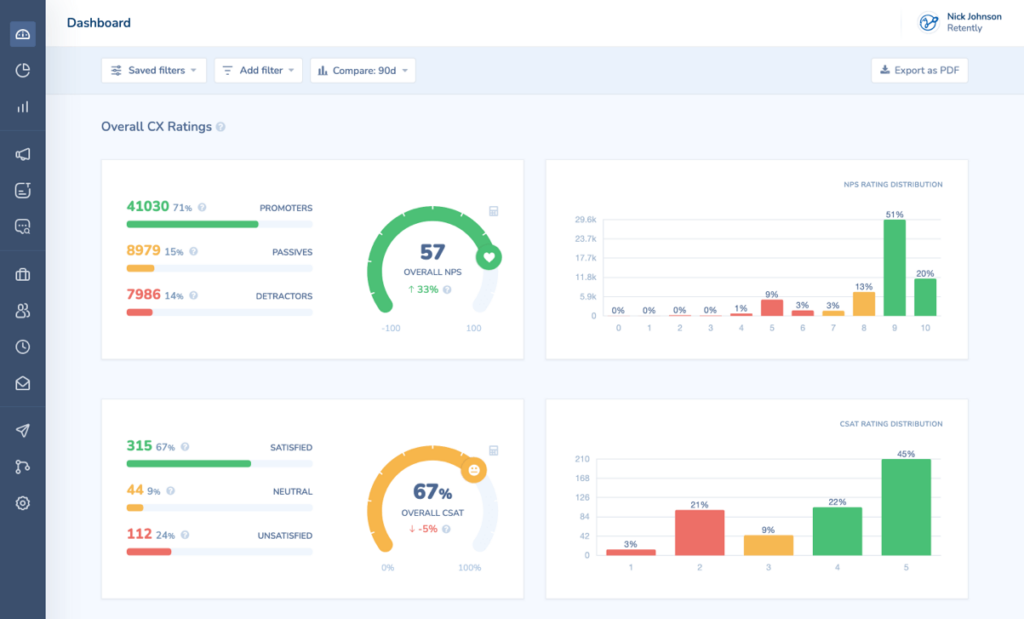
2. Qualaroo: Real-Time Feedback, Exactly When You Need It
Qualaroo is designed to help companies gather meaningful customer feedback right within their digital products. Whether it’s tracking Customer Effort Scores on a website, mobile app, or even prototypes, Qualaroo enables teams to collect insights from real users in the moment. No matter the metric – CES, or if you’re opting for NPS or CSAT data – Qualaroo adapts to user needs with a flexible platform.
Key Features
- Qualaroo-Nudges™: Customizable, well-timed prompts that blend into your website or app without disrupting the user journey.
- Targeted Surveys: Behavioral triggers display surveys at the right moment – such as post-purchase or after a support interaction.
- Sentiment Analysis: AI-powered tools, backed by IBM Watson, decode open-ended responses to uncover the root cause for high effort.
- Advanced Targeting: Surveys delivered to specific user segments based on behavior, location, or device.
- In-App and Mobile-Friendly Surveys: Designed for seamless feedback collection within iOS and Android apps, surveys are optimized to enhance the experience of mobile users.
- Design Flexibility: Customized surveys with your brand’s colors, logo, and messaging, with positioning options to fit specific pages or app screens.
- Integrations: Supports Google Analytics, Slack, HubSpot, and APIs to enrich data ecosystems.
What Makes It Unique?
Qualaroo collects feedback in the moment with its signature “Nudges” which are subtle and feel natural to users. These Nudges are used for understanding customer effort without disrupting the user experience.
Pricing
- Free Plan: Free for up to 50 responses/month (includes 500 email sends and 10,000 pageviews).
- Business Plan: At a price tag of $39.99/month for 100 responses, it covers 5,000 email sends and 100,000 pageviews. It also includes unlimited Nudges, advanced targeting, mobile Nudges, sentiment analysis, and multi-lingual surveys.
- Add-ons: White Label Package: For $30/month.
Best Fit For
Qualaroo is best suited for those aiming to capture real-time, contextual feedback to optimize website and app interactions.
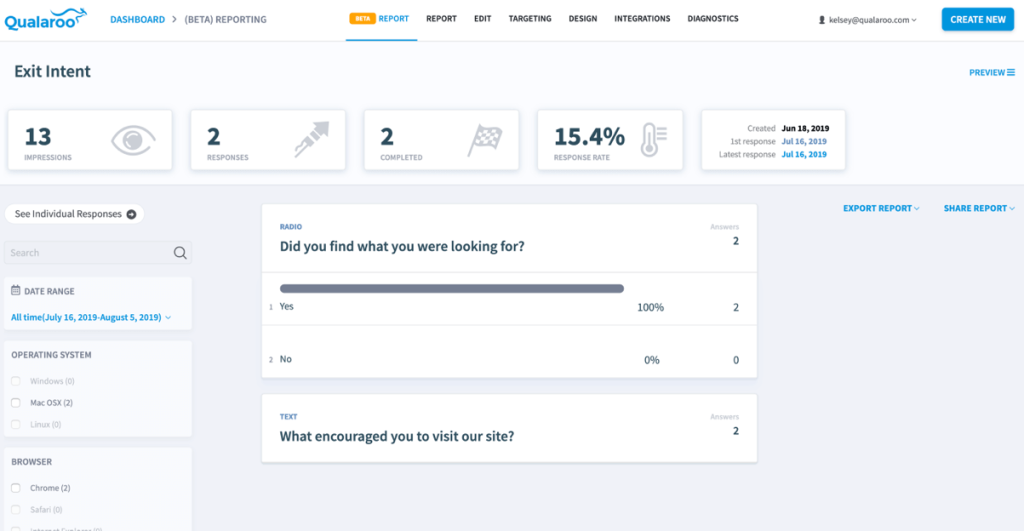
3. Qualtrics: The Enterprise Powerhouse
Qualtrics is an experience management platform designed with enterprise-level capabilities. It helps businesses measure and improve Customer Effort Score alongside other key experience metrics like NPS and CSAT. Its ability to handle CES data across multiple touchpoints – while offering real-time analytics and predictive insights – makes it valuable for identifying and addressing customer friction points, especially in large and diverse markets.
Key Features
Qualtrics offers a suite of tools and customization options that enable comprehensive CES measurement as follows:
- Versatile Survey Creation: Surveys can be crafted specifically to capture CES insights, helping teams pinpoint where customers may be encountering effort barriers.
- Multi-Channel Surveys: Distribute surveys via email, SMS, in-app pop-ups, and more to reach customers on their preferred platforms.
- AI-Powered Insights: Uses AI to uncover trends and predict customer behavior, enabling proactive decision-making.
- Adaptive Customization: Surveys dynamically adjust based on customer responses, personalizing the experience and capturing more accurate CES feedback.
- Insightful Dashboards: Provides customizable dashboards to visualize CES data and trends. Stakeholders at all levels can access relevant insights, while permission controls ensure each team views only the data pertinent to their roles.
- Seamless Integrations: Connect with CRM systems like Salesforce and marketing tools such as Marketo to unify customer data and streamline workflows.
- Automated Actions: Includes automation features like follow-up emails and ticket routing, allowing teams to address customer effort issues promptly.
What Makes It Unique?
Qualtrics is built for scale, making it a relevant choice for organizations managing feedback across multiple regions or large customer bases. By supporting both customer and employee experience on one platform, it helps align internal operations with customer needs.
Pricing
Custom pricing is available upon request, tailored to the specific needs of each organization. There is no free trial available to test the product.
Best Fit For
Qualtrics offers a comprehensive set of tools for capturing and analyzing CES, making it suitable for large organizations looking to manage customer effort. However, it’s not the easiest platform for beginners to pick up, and the wide range of features can sometimes feel excessive, leading to a more complex user experience than some teams may need.
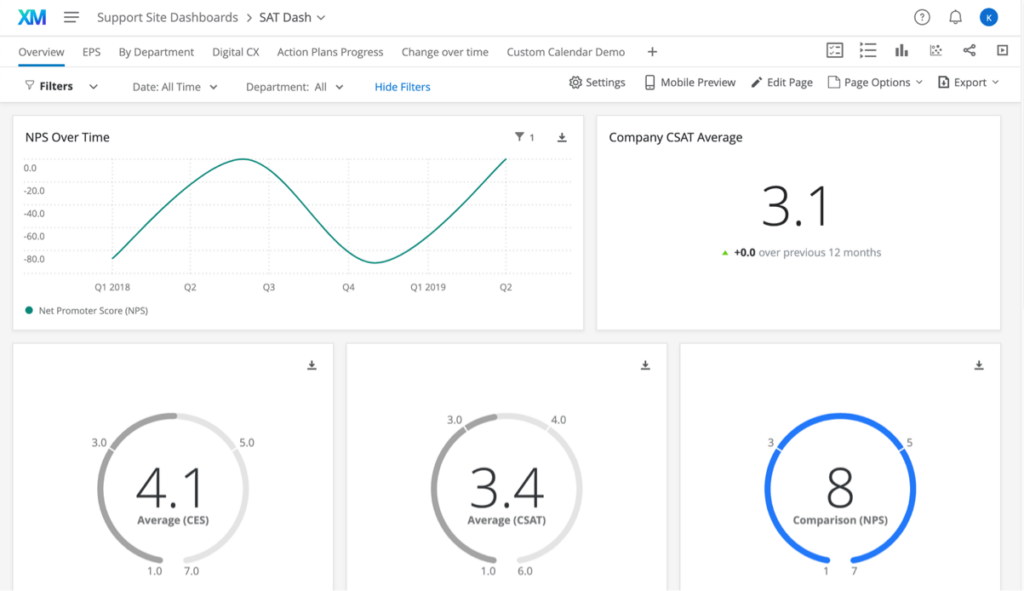
4. Nicereply: A Feedback Tool for Support Teams
Nicereply is a feedback platform tailored for customer support teams to measure and improve service interactions. It focuses on CES along with CSAT and NPS surveys. By integrating with popular helpdesk platforms, Nicereply allows teams to gather, analyze, and act on feedback efficiently. The tool offers customization options and analytics features to help businesses understand customer sentiment, respond to issues quickly and improve their processes.
Key Features
- Survey Deployment: Deploy CES surveys via email, support tickets, website pop-ups, or direct links, ensuring feedback is collected at key touchpoints.
- Integration with Helpdesk Systems: Works well with Zendesk, Front, Helpscout, Pipedrive, and other platforms, integrating feedback management into existing workflows.
- Customizable Templates: Users can design surveys to align with their brand, enhancing consistency and engagement.
- Real-Time Notifications: Provides instant alerts for feedback, enabling teams to address customer issues promptly.
- Feedback Analytics: Provides easy-to-read charts and reports to help teams identify high-effort interactions that need immediate attention.
What Makes It Unique?
Nicereply stands out for its focus on post-interaction surveys. After resolving a support ticket, the tool can automatically send a CES survey asking, “How easy was it to get help?” This immediate feedback loop helps support teams identify friction points and continuously refine their processes. The ability to integrate seamlessly with helpdesk tools ensures that feedback is connected directly to individual customer interactions, making it actionable and relevant.
Pricing
Nicereply offers multiple plans to suit teams of different sizes and needs:
- Starter Plan: At $79 per month, this plan includes up to 100 responses per month and access for 3 users.
- Essential Plan: At $149 per month, it offers up to 250 responses per month and supports 10 users.
- Growth Plan: This plan costs $299 per month and includes 1,000 responses per month with access for 25 users.
- Business Plan: The Business Plan costs $449 per month and provides 2,500 responses per month and access for 50 users.
The plans can be tested in a 14-day free trial.
Best Fit For
Despite some reported hiccups, NiceReply is a good choice for teams seeking an easy-to-use CES tool with essential features for monitoring and improving customer effort. With its focus on post-interaction feedback, helpdesk integrations, and analytics, the tool works well for businesses aiming to quickly implement feedback tracking without a complex setup.
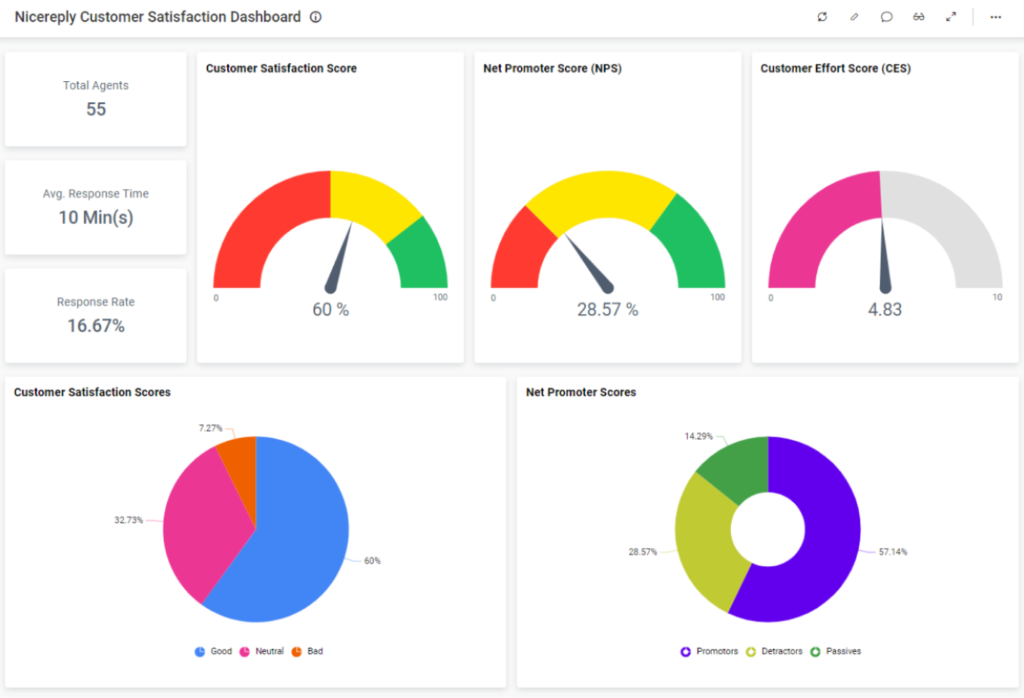
5. Hotjar: Behavioral Insights Meet CES
Hotjar is a behavioral analytics platform known for its heatmaps and session recordings, but its feedback features make it a relevant choice for measuring CES alongside user behavior. With its ability to blend behavioral data and customer feedback, Hotjar helps businesses identify friction points and reduce user effort.
Key Features
- On-Site Surveys: Deploys CES surveys directly on your website or app to gather feedback in real-time. Surveys are customizable, allowing you to tailor questions and branding to fit your needs.
- Behavioral Analytics: Leverages heatmaps and session recordings to visualize user behavior. Combining this data with CES results reveals where users struggle and why, providing actionable insights.
- User-Friendly Interface: The design allows businesses to set up surveys and analyze data without technical expertise, making it accessible for teams of all sizes.
- Integrations: Connects with tools like Google Analytics, Slack, and HubSpot to centralize data and streamline workflows.
- AI-Powered Sentiment Analysis (Available in Business and Scale Plans): Deeper insights by analyzing open-ended responses for sentiment and themes, helping to uncover the emotions behind customer feedback.
What Makes It Unique?
Hotjar’s strength lies in its ability to correlate CES feedback with behavioral data. For example, a low CES score during checkout can be cross-referenced with heatmaps to identify specific points of friction, such as an unclear button or a complex form. This combined analysis enables targeted improvements that directly address user pain points.
Pricing
- Basic Plan: The free plan includes up to 20 monthly responses, 3 surveys, and feedback widgets, access to survey templates, and Hotjar AI for Surveys. It is relevant for those starting with basic CES surveys and feedback collection.
- Plus Plan: It costs €59/month and includes unlimited surveys and feedback widgets, up to 250 monthly responses, an Events API for targeting, and advanced filtering options. It’s best for those requiring more responses and targeted surveys.
- Business Plan: At €79/month, it features up to 500 monthly responses, AI-powered sentiment analysis, custom branding, survey performance analytics, and custom integrations. It’s relevant for those needing more advanced analysis and customization.
- Scale Plan: At €159/month, includes 500+ monthly responses, access to the Hotjar API, webhooks, SAML single sign-on (SSO), and a dedicated customer success manager.
Best Fit For
Hotjar is helpful for ecommerce platforms, content-rich websites, and businesses looking to combine behavioral insights with CES feedback. It’s relevant for identifying and fixing friction points in customer journeys, making it an interesting tool for reducing effort. Yet, as a behavioral analytics tool, it lacks the depth and specialized features of dedicated CX platforms, such as advanced CES-focused reporting and benchmarking.
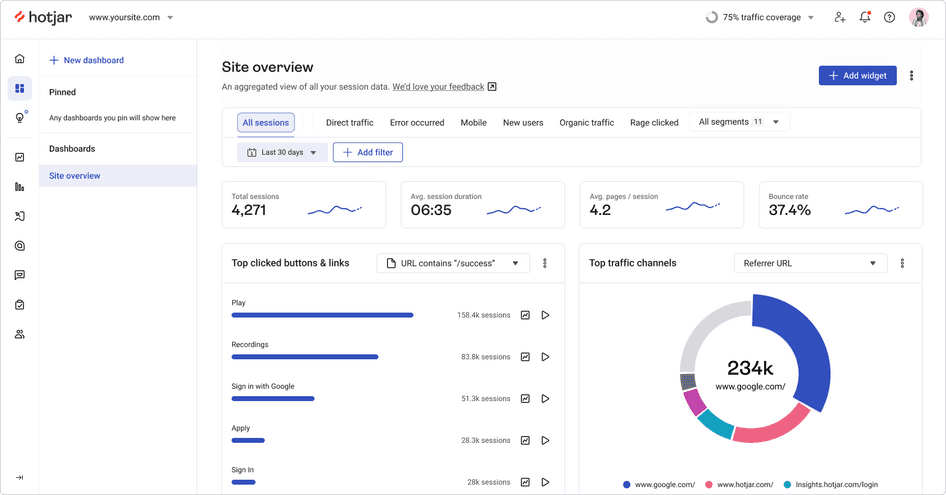
Final Thoughts
CES is your lens into the everyday hurdles customers face when interacting with your brand. Whether it’s finding information, resolving an issue, or completing a simple task, today’s users demand quick, seamless experiences. They have little patience for confusing processes, long wait times or unresponsive support. Even minor obstacles – like a slow-loading website or a complicated returns process – can drive them away for good.
That’s exactly what CES aims to prevent. By measuring effort, CES pinpoints exactly where customers feel they’re working too hard to get what they need and gives businesses the insight to smooth out these rough patches. CES isn’t just a tool for measuring effort; it’s a strategy for removing it at every touchpoint and turning friction into loyalty.
We’ve explored the top CES tools, each with its unique strengths, from Retently’s automation and deep analytics to Hotjar’s behavioral insights. The key takeaway? The right tool can transform your customer experience efforts by providing actionable insights to refine your customer journey. But the success of your CES strategy depends on more than the tool – it hinges on how well you use it. Focus on clear survey design, strategic deployment, and, most importantly, acting on the feedback you receive.
Now’s the time to take the next step toward effortless customer experiences. Choose the CES tool that aligns with your goals, act on your findings, and watch your customer satisfaction and loyalty soar!


































 Christina Sol
Christina Sol 


 Greg Raileanu
Greg Raileanu 

